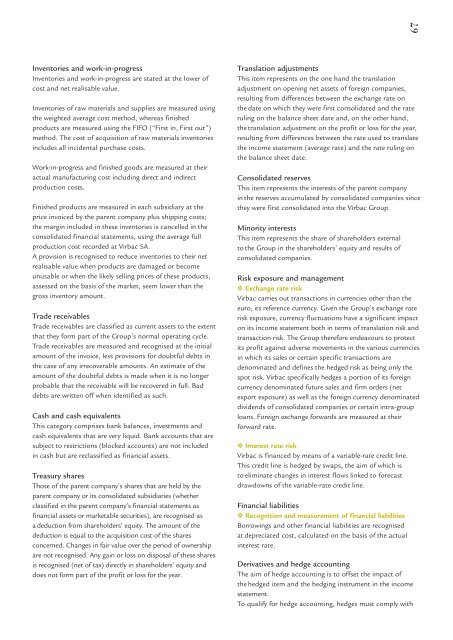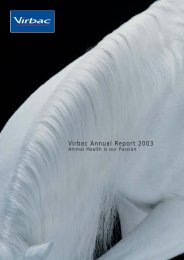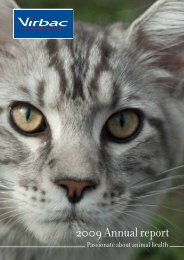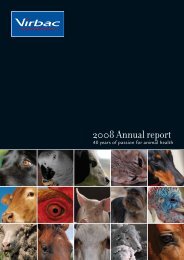2005 Annual report - Virbac
2005 Annual report - Virbac
2005 Annual report - Virbac
Create successful ePaper yourself
Turn your PDF publications into a flip-book with our unique Google optimized e-Paper software.
67<br />
Inventories and work-in-progress<br />
Inventories and work-in-progress are stated at the lower of<br />
cost and net realisable value.<br />
Inventories of raw materials and supplies are measured using<br />
the weighted average cost method, whereas finished<br />
products are measured using the FIFO (“First in, First out”)<br />
method. The cost of acquisition of raw materials inventories<br />
includes all incidental purchase costs.<br />
Work-in-progress and finished goods are measured at their<br />
actual manufacturing cost including direct and indirect<br />
production costs.<br />
Finished products are measured in each subsidiary at the<br />
price invoiced by the parent company plus shipping costs;<br />
the margin included in these inventories is cancelled in the<br />
consolidated financial statements, using the average full<br />
production cost recorded at <strong>Virbac</strong> SA.<br />
A provision is recognised to reduce inventories to their net<br />
realisable value when products are damaged or become<br />
unusable or when the likely selling prices of these products,<br />
assessed on the basis of the market, seem lower than the<br />
gross inventory amount.<br />
Trade receivables<br />
Trade receivables are classified as current assets to the extent<br />
that they form part of the Group’s normal operating cycle.<br />
Trade receivables are measured and recognised at the initial<br />
amount of the invoice, less provisions for doubtful debts in<br />
the case of any irrecoverable amounts. An estimate of the<br />
amount of the doubtful debts is made when it is no longer<br />
probable that the receivable will be recovered in full. Bad<br />
debts are written off when identified as such.<br />
Cash and cash equivalents<br />
This category comprises bank balances, investments and<br />
cash equivalents that are very liquid. Bank accounts that are<br />
subject to restrictions (blocked accounts) are not included<br />
in cash but are reclassified as financial assets.<br />
Treasury shares<br />
Those of the parent company’s shares that are held by the<br />
parent company or its consolidated subsidiaries (whether<br />
classified in the parent company’s financial statements as<br />
financial assets or marketable securities), are recognised as<br />
a deduction from shareholders’ equity. The amount of the<br />
deduction is equal to the acquisition cost of the shares<br />
concerned. Changes in fair value over the period of ownership<br />
are not recognised. Any gain or loss on disposal of these shares<br />
is recognised (net of tax) directly in shareholders’ equity and<br />
does not form part of the profit or loss for the year.<br />
Translation adjustments<br />
This item represents on the one hand the translation<br />
adjustment on opening net assets of foreign companies,<br />
resulting from differences between the exchange rate on<br />
the date on which they were first consolidated and the rate<br />
ruling on the balance sheet date and, on the other hand,<br />
the translation adjustment on the profit or loss for the year,<br />
resulting from differences between the rate used to translate<br />
the income statement (average rate) and the rate ruling on<br />
the balance sheet date.<br />
Consolidated reserves<br />
This item represents the interests of the parent company<br />
in the reserves accumulated by consolidated companies since<br />
they were first consolidated into the <strong>Virbac</strong> Group.<br />
Minority interests<br />
This item represents the share of shareholders external<br />
to the Group in the shareholders’ equity and results of<br />
consolidated companies.<br />
Risk exposure and management<br />
❖ Exchange rate risk<br />
<strong>Virbac</strong> carries out transactions in currencies other than the<br />
euro, its reference currency. Given the Group’s exchange rate<br />
risk exposure, currency fluctuations have a significant impact<br />
on its income statement both in terms of translation risk and<br />
transaction risk. The Group therefore endeavours to protect<br />
its profit against adverse movements in the various currencies<br />
in which its sales or certain specific transactions are<br />
denominated and defines the hedged risk as being only the<br />
spot risk. <strong>Virbac</strong> specifically hedges a portion of its foreign<br />
currency denominated future sales and firm orders (net<br />
export exposure) as well as the foreign currency denominated<br />
dividends of consolidated companies or certain intra-group<br />
loans. Foreign exchange forwards are measured at their<br />
forward rate.<br />
❖ Interest rate risk<br />
<strong>Virbac</strong> is financed by means of a variable-rate credit line.<br />
This credit line is hedged by swaps, the aim of which is<br />
to eliminate changes in interest flows linked to forecast<br />
drawdowns of the variable-rate credit line.<br />
Financial liabilities<br />
❖ Recognition and measurement of financial liabilities<br />
Borrowings and other financial liabilities are recognised<br />
at depreciated cost, calculated on the basis of the actual<br />
interest rate.<br />
Derivatives and hedge accounting<br />
The aim of hedge accounting is to offset the impact of<br />
the hedged item and the hedging instrument in the income<br />
statement.<br />
To qualify for hedge accounting, hedges must comply with








